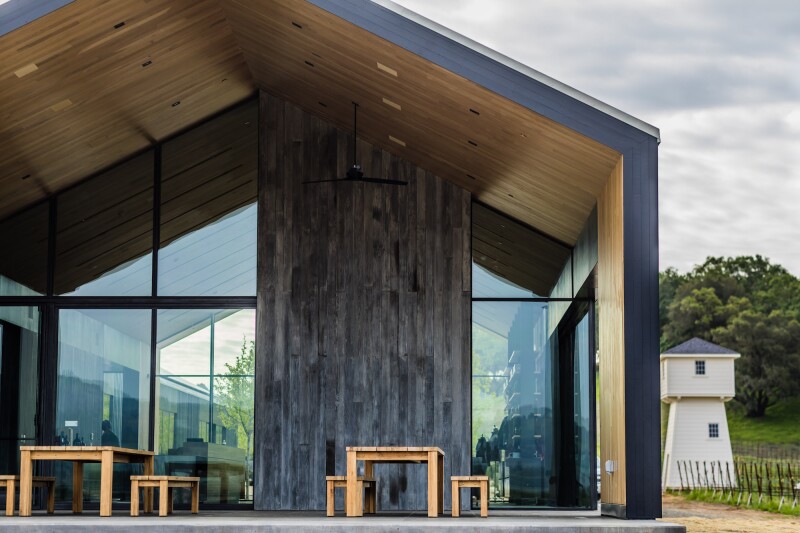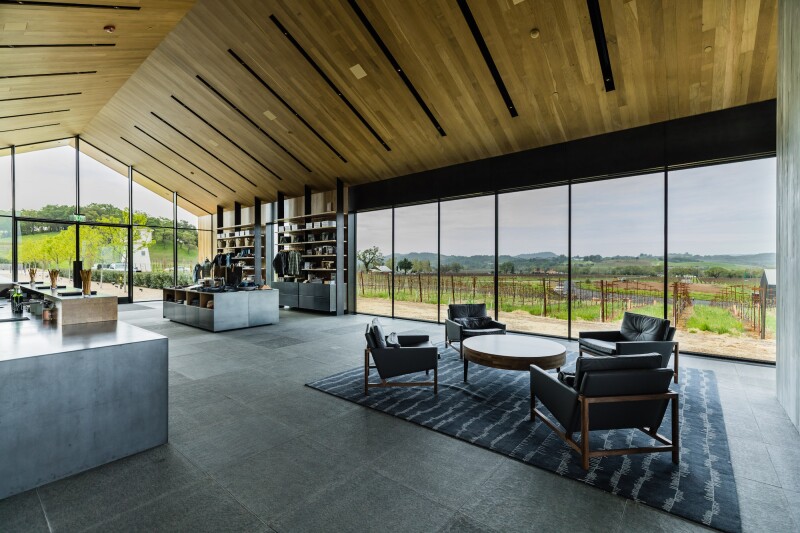For many, the name Silver Oak brings to mind one thing: a bottle of luxurious California cabernet wrapped in a shiny silver label. Since Raymond Twomey Duncan cofounded the winery in 1972, the wines have become cult favorites, gathering acclaim, a roster of celebrity customers (Oprah and Patrick Dempsey are both fans), and a few acquisitions along the way. With the opening of its new, (almost) LEED platinum–certified Alexander Valley winery in Healdsburg, the brand hopes to tie the name to a new image: that of the most sustainable winery in the world.
The winery—open to the public as of May 2—isn’t Silver Oak’s first foray into the world of green building. In 2016, the company’s Oakville, Napa, winery became the first LEED platinum–certified production winery in the country. But when dreaming up the new Sonoma winery, president David Duncan knew he wanted to take things one step further.
Duncan and his team spent the next four years crafting a winery that would meet both LEED’s standards and those of the Living Building Challenge, a rigorous set of guidelines that require a building to be completely self-sufficient—that is, not connected to a public water or energy supply, among many other things.

Salvaged materials are the star of the show: The Silver Oak team used felled oak trees for floors and repurposed 1930s-era redwood wine tanks as exterior siding.
Courtesy of Silver Oak
Let’s nerd out for a moment, shall we? The new winery includes the requisite solar panels and low-water fixtures most of us associate with green architecture. But water conservation is a huge part of meeting the Living Building Challenge. To irrigate the winery’s 75 acres of cabernet vines, Silver Oak harvests rainwater, storing it in enormous underground tanks. The real beauty is the way in which that water is reclaimed and recycled, again and again. David and his team installed a membrane bioreactor, which sounds wildly technical but is really just giant filtration system that uses a combination of fine-mesh filters and natural biological activity to clean water. The resulting water “comes out pretty much clear,” says Haley Duncan, the winery’s sustainability lead (and David Duncan’s niece).
It will take a year a year or more to gain the Living Building certification, Haley says, though the winery expects to receive its LEED platinum certification this fall. “For the Living Building Challenge, it’s not just about design but also about [the building] performing the way you said it would,” she explains.
“I wanted it to feel like a barn fell out of the sky and landed in the vineyard.”
The materials that compose the winery are equally, fascinatingly green. Old redwood wine barrels were dismantled and repurposed as exterior siding. Felled oak trees were transformed into flooring and interior wall paneling. The walls are insulated with EcoBatt, a chemical-free material made from salvaged denim scraps.
“Before you closed up the walls, you could see little threads,” Haley says.
Other highlights include 11 electric vehicle charging stations, an all-electric kitchen complete with a fancy electric grill (remember, no fossil fuels allowed), and, in the winery’s office, a staircase made from salvaged wine barrels, complete with red wine stains.
“It’s pretty cool to see something that would normally just get broken down transformed into this beautiful functional thing,” she says.
All that good green stuff is wrapped in an airy, modern, barnlike shell that would make Ansel Adams weep.
“I wanted it to feel like a barn fell out of the sky and landed in the vineyard,” David says.
Architect Daniel Piechota picked up that idea and ran with it. His firm, Sagan Piechota Architecture, is known for its ability to blend architecture into the surrounding landscape without sacrificing style—and the Silver Oak winery is no exception.

Architect Daniel Piechota designed the tasting room to frame the winery’s 75 acres of cabernet vines.
Courtesy of Silver Oak
“I was really drawing on the barns around the Alexander Valley,” Piechota says. “I thought that was a good way to marry the valley [in the project]—but not make it look overtly like a barn. We used the form and scale of a barn to evoke a feeling of the Alexander Valley.”
Piechota prized views above all else, installing so many floor-to-ceiling windows that, when standing inside, you still feel part of the landscape.
“[We treated] the building as a way to frame the vineyard,” he says. “It was all about not detracting from the view.”
The best way to get a taste of the winery is by visiting. Tastings with fewer than six people don’t require a reservation. But Silver Oak also offers guided tours of the winery and vineyard ($30 per person, tasting included) and food-and-wine pairings under the expert hand of chef Dominic Orsini ($90 per person, tour included). Book both here.
While other wineries have incorporated elements of sustainable architecture, Silver Oak is the first to pursue such aggressive certification. David and Haley say they hope to be a resource for fellow winemakers.
“Moving forward, I think it’s important to open the project to others in the winemaking community who want to do something similar,” Haley says. “We’ve learned a lot over the past four years, and we would love to share with others.”











